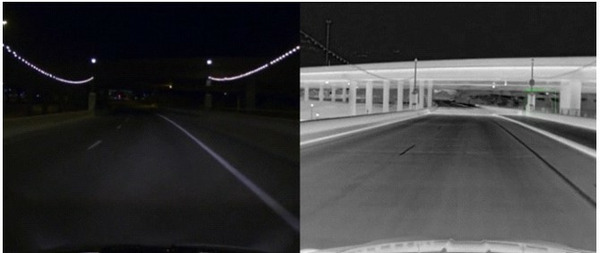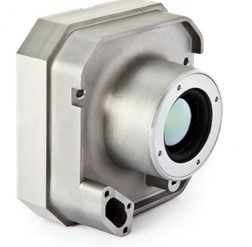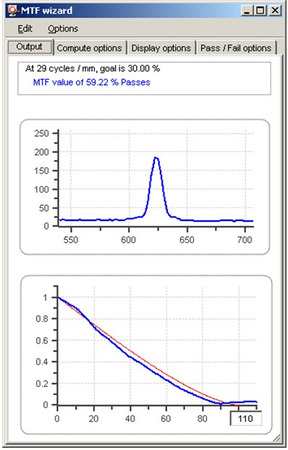Standard vision systems, using visible-light cameras, rely on light from the sun, or street lighting, limiting their use in low-lighting conditions. Thermal Imaging Night Vision Systems, in contrast, use the thermal energy (heat) emitted by all objects to allow for 'sight', even in complete darkness.
A recent study into Automatic Emergency Braking (AEB) systems highlights the necessity for thermal imaging cameras in vehicles equipped with ADAS.³ Performed by the AAA, the study found that AEB systems with pedestrian detection were completely ineffective at night. The four car models evaluated had radar and visible cameras, but not thermal imaging cameras. During the day, these vehicles were able to detect and avoid a proportion of collisions with adult pedestrians (~40% when the vehicle was travelling at 20mph). However, during the night, the AEB system failed to detect even one adult pedestrian, at any vehicle speed. Without thermal imaging, such a system is limited to use only in the day.
Having a Night Vision System with thermal imaging is not enough in itself. For Night Vision systems to be effective, they must be equipped with high sensitivity, high performance athermalized (i.e., stay in focus at all temperatures) lenses, that allow for long distance hazard detection, and even object classification, to provide the driver with sufficient response time and information about the type of hazard ahead. These optics must also maintain high image quality and full operability in the harshest environmental conditions.
Developing high performance optics for the automotive industry involves many challenges.
High image quality ADAS and AV (autonomous vehicle) systems are based on AI (artificial intelligence) algorithms, which analyze captured images in real time and identify potential obstacles and humans, in order to take action and avoid collisions. Obviously, to be effective, these systems must recognize and identify the objects from large distances, so that the system can take action in a timely manner, and with extremely high reliability, with no false alarms. To achieve these goals, the images must have the highest quality available, i.e. diffraction limited. This means that both the IR detector and lens must be of the highest level of performance. When using the most advanced IR detectors, an improvement in lens quality is necessary to take full advantages of advances in detector performance. In other words – lens quality is essential. An inferior lens will produce an inferior image, even with the best detector. In order to match high performance detectors, lower F#s and tighter tolerances are required, forming lenses with minimal aberrations.
Optics must also feature:
- Compact size
- Athermalization – essential for the continuous full operation of the system at any temperature during driving.
- Full operation in all environmental conditions – including extreme temperatures, high humidity, severe shock and vibrations, thermal shock, impact resistance, as well as exposure to chemicals, salt spray and blowing sand.
- Low cost – the challenge is to design and manufacture a lens with both high quality and low cost, for costeffectiveness for the mass market.
In order to meet the requirements of thermal imaging night vision systems, Ophir utilizes its vast knowledge and experience in designing and manufacturing lenses for the automotive industry for many years. Starting with several innovative optical and mechanical design alternatives, Ophir analyzes the tradeoffs of each alternative, and select the most cost effective design, taking into account both performance and cost.
When selecting the final design concept, multiple considerations are taken into account: nominal performance, tolerance sensitivity, manufacturability, raw material costs and availability, manufacturing and assembly costs, testability, and risks.
Aspheric and diffractive surfaces are often used in Ophir's optical designs, in order to reduce aberrations and improve image quality, while minimizing the number of optical elements. This reduces size, weight and cost. Diamond turning technology can produce these aspheric and diffractive surfaces, with exceptional levels of accuracy and quality. Aspheric lens surfaces are desirable, particularly when it comes to infrared optics, showing significant increases in optical performance over their spherical counterparts. Aspheric-Diffractive lens surfaces allow for the integration of multiple functions, such as chromatic and spherical aberration corrections.
Product features When it comes to optics for night vision and ADAS systems, Ophir's range of products feature the following capabilities:
- High MTF
- Up to 51.1° HFOV
- QVGA or VGA resolution availability, at 12, 17 and 25 μm pixel pitch
- High volume manufacturing
After design selection, Ophir moves on to prototype production, using cutting-edge equipment and manufacturing processes to produce the highest quality IR optical components.
Following the production of the optical elements, lens assembly and testing is preformed by utilizing an advanced and fully equipped R&D lab. The whole process ensures a high quality, cost-effective product for the automotive market.




 Ultra-High Velocity
Ultra-High Velocity